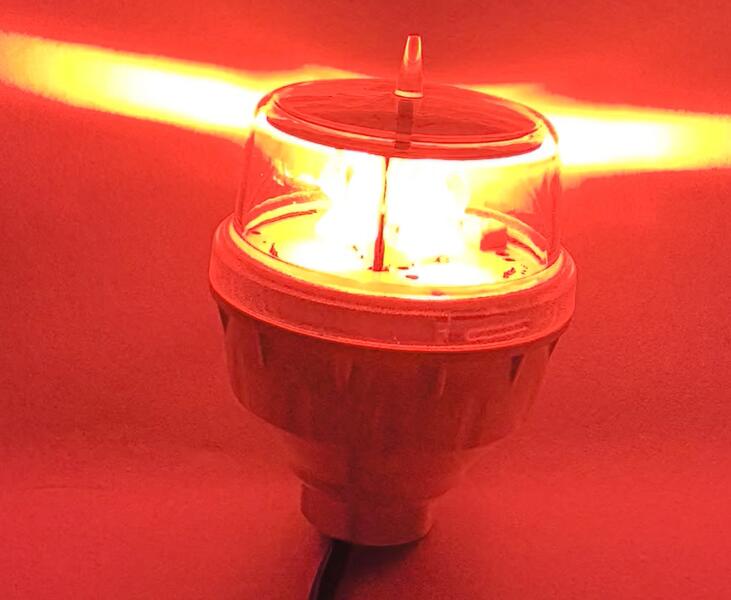LED Aviation Obstruction Light: Revolutionizing Airspace Safety with Modern Technology
The aviation industry relies on reliable, high-performance lighting systems to ensure the safety of aircraft navigating around tall structures. LED aviation obstruction light solutions have transformed the market, offering superior visibility, energy efficiency, and durability compared to traditional lighting technologies. This article explores the benefits, regulatory compliance, and applications of LED aviation obstruction light systems, demonstrating why they have become the preferred choice for modern airspace safety.
Why LED Technology Dominates Aviation Obstruction Lighting
Traditional incandescent and halogen obstruction lights are being rapidly replaced by LED aviation obstruction light systems due to their significant advantages:
1. Exceptional Energy Efficiency
LEDs consume up to 80% less power than conventional bulbs, reducing operational costs.
Lower energy requirements make them ideal for solar-powered and off-grid installations.
2. Extended Lifespan
50,000+ hours of operation (compared to 1,000–2,000 hours for incandescent bulbs).

Fewer replacements mean reduced maintenance labor and downtime.
3. Superior Visibility & Reliability
Instant illumination with no warm-up time, crucial for aviation safety.
High-intensity output ensures compliance with FAA, ICAO, and Transport Canada standards.
| led aviation obstruction light |
Consistent performance in extreme temperatures (-40°C to +70°C).
4. Durability & Weather Resistance
Solid-state LED construction resists vibrations, shocks, and impacts.
IP67 or higher waterproof ratings protect against rain, snow, and dust.
Corrosion-resistant materials ensure longevity in coastal and industrial environments.
| led aviation obstruction lights |
Regulatory Compliance for LED Aviation Obstruction Lights
To be approved for use, LED aviation obstruction light systems must meet strict international standards:
1. FAA (Federal Aviation Administration) Standards
AC 70/7460-1L – Defines lighting requirements for structures affecting navigable airspace.
L-810 (Red Obstruction Lights) – Low-intensity LEDs for structures under 150 feet (45m).
L-864/L-865 (Medium-Intensity) – For structures between 150–500 feet (45–150m).
L-856/L-857 (High-Intensity) – For structures exceeding 500 feet (150m).
2. ICAO (International Civil Aviation Organization) Annex 14
Specifies Type A, B, and C lighting based on structure height and location.
Requires dual lighting systems (red beacons at night, white strobes during the day) for maximum visibility.
3. Transport Canada & EASA (Europe) Regulations
Similar to FAA but may include additional regional requirements.
Mandates synchronized flashing for clusters of structures (e.g., wind farms).
Key Applications of LED Aviation Obstruction Lights
1. Communication & Broadcast Towers
Telecom towers in remote areas benefit from low-power LED aviation obstruction light systems with solar compatibility.
2. Wind Turbines & Renewable Energy Farms
Wind turbines require medium- to high-intensity LED lights to prevent collisions with low-flying aircraft.
3. Skyscrapers & Urban High-Rise Buildings
Dual-mode LED systems automatically switch between day (white strobe) and night (red beacon) operation.
4. Cranes & Temporary Construction Structures
Portable LED aviation obstruction light kits ensure compliance during building projects.
Technological Advancements in LED Obstruction Lighting
The latest innovations in LED aviation obstruction light technology include:
1. Smart Monitoring & IoT Integration
Remote diagnostics via cellular or satellite connectivity.
Automatic fault alerts and predictive maintenance notifications.
2. Adaptive Lighting Systems
Adjusts brightness based on ambient light and weather conditions.
Reduces light pollution while maintaining compliance.
3. Solar-Powered & Hybrid Solutions
Ideal for off-grid installations with battery backup for uninterrupted operation.
Installation & Maintenance Best Practices
To maximize performance, follow these guidelines:
Strategic Placement – Install at the highest point and mid-levels if required.
Regular Inspections – Check for dirt, snow, or damage after extreme weather.
Power Redundancy – Use backup batteries or solar to prevent outages.
Future Trends in LED Aviation Lighting
AI-Powered Predictive Maintenance – Detects failures before they occur.
Enhanced Sustainability – More solar-compatible and recyclable designs.
Improved Optics – Brighter, longer-range visibility with lower power draw.
LED aviation obstruction light systems represent the gold standard in aviation safety, offering unmatched efficiency, durability, and compliance. As technology advances, these lights will continue to evolve, further enhancing airspace safety worldwide. By investing in high-quality LED aviation obstruction light solutions, industries can ensure regulatory compliance while minimizing long-term operational costs.
